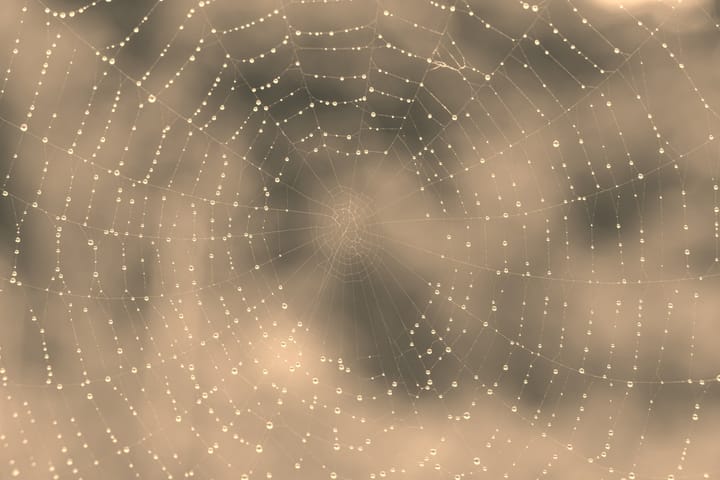Which Indian fabric once sparked a revolution in trade and fashion?
Prepare to dive into a world of forbidden fabrics, industrial espionage, and a textile revolution on the brink, as we journey to the heart of the luxurious Indian fabric Chintz has ignited a global fashion revolution.

It originated in India and went on to dominate the western interiors and fashion. Yet this humble fabric remains a chapter from the #indianhistory we seldom hear about.
Bharat’s textile innovations and their influences on fashion, trade, and industry were widespread around the world, even in places as far as Cairo, Japan, Sumatra, London, and Ottawa. They were the luxury fabric of their day! Desired by all, it was one of the great inventions that drew foreigners to India’s shores hungry for more.
Chintz was one such prized possession.
Before we jump into how it revolutionised trade and fashion, let's understand what made it so luxurious and desired. How was it produced?
The excerpt below summarises the state of play. Simply put, the world, including Europe did not have anything like it at the time!


Nations around the world wanted the Indian chintz - It was uniquely bright and had beautiful patterning.
Chintz was originally a woodblock printed, painted or stained calico that was produced in Golconda, Hyderabad. The skilled craftspeople of Bharat had perfected the complex art of painting and printing cotton cloth. They used natural dyes to create vibrant colours and dynamic designs that have endured for hundreds of years.
Most of us aren’t aware that it is tough to get the cotton cloth to absorb and retain coloured dyes. The process for creating these coloured patterns even today is long and technically challenging.
So how exactly did the Indian artisans master and dominate this difficult craft several centuries ago?
New research has revealed some answers though the precise science remains a mystery. Here’s a snapshot of the complex process.
- The pre-treatment was elaborate and could take weeks. The cloth was flattened and burnished with buffalo milk and myrobolan (amla) to give it a smooth surface. The protein in the milk probably provided bonding sites for the dyes.
- Rinsed with a solution of myrobalan fruit, animal dung from goats, sheep, or camels urine as required. This particular process is called animalising the cloth which we will refer to later.
- Then the pattern was drawn on paper. Powdered charcoal was rubbed on the paper to transfer the pattern to the fabric. Once the design was transferred to the cloth, the outlines were painted in.
- Then, the entire fabric surface was coated with wax except for those areas designed to be blue or green in the finished fabric. The fabric was immersed in an indigo vat, a requirement to fasten the colours blues and greens.
- After immersion in indigo, the dye was oxidized in the air and the fabric was dried. Then the fabric was scraped and washed to remove the wax - which was reused for the next design.
- Rest of the design was achieved by painting on a combination of something called mordants along with thickening agents followed by dipping the fabric in what's called a madder bath.
- Colours you could obtain with mordants were orange, brown, pink, crimson, lilac, purple, and black. Washing the fabric removed most of the madder in the non-mordanted areas. The fabric was then aged in the sun to remove any residual colour in the non-mordanted areas and to set the colour in the mordanted areas.
Long story short, what we heard is a long complex chemical process that takes an arduous amount of time and great care. Now there are many more unsung heroes of Indian chintz including the animal dung that provides the complex ammonia and proteins necessary to bleach and brighten colours or the unsuspecting rice water which provides a shiny coating or glaze to the finished piece.
So you see...Indian artisans combined skills in weaving cotton, painting, printing, dyeing, bleaching, and glazing. They developed and perfected these skills using what may seem like really humble ingredients and tools and that was their true genius.
Isn’t that a phenomenal story we’ve never heard about? Can this level of skill and mastery be achieved in a short period or is it the result of antiquity? What do you think?
These are our stories in our voices. Let's Own it...Wear it - Be unapologetic.
If you enjoy the content, do leave a comment, subscribe, and share with at least one other person.
This is the first of a four-part series.
Reference materials for the information in this series:
- Riello, G. (n.d.). The Rise of Calico Printing in Europe and the Influence of Asia in the Seventeenth and Eighteenth Centuries. https://www.lse.ac.uk/Economic-History/Assets/Documents/Research/GEHN/GEHNConferences/conf8/PUNERiello.pdf
- Bekhrad, J., n.d. The Floral Fabric That Was Banned. [online] Bbc.com. Available at: https://www.bbc.com/culture/article/20200420-the-cutesy-fabric-that-was-banned
- En.wikipedia.org. n.d. Chintz. [online] Available at: https://en.wikipedia.org/wiki/Chintz
- Fee, S., n.d. THE CLOTH THAT CHANGED THE WORLD: India’S Painted And Printed Cottons. [online] Rom.on.ca. Available at: https://www.rom.on.ca/sites/default/files/imce/pdf/chintz_audioguide_transcript.pdf
- Instagram. n.d. About Chintz. [online] Available at: https://www.instagram.com/p/B7AOhSsJ8Xu
- Yafa, S., 2014. Cotton. New York: Penguin Books.
- Zanten, V., 2020. Chintz 101: A Primer For The Print That’S Back In A Big Way. [online] Vogue. Available at: <https://www.vogue.com/article/chintz-prints-to-know>
- New Internationalist. n.d. Cotton - A History. [online] Available at <https://newint.org/features/2007/04/01/history>
- The Inside Blog. n.d. A Brief History Of Chintz - The Inside Blog. [online] Available at: https://www.theinside.com/blog/a-brief-history-of-chintz/
- Shahani, G. (2008). “A Foreigner by Birth”: The Life of Indian Cloth in the Early Modern English Marketplace. In: Sebek, B., Deng, S. (eds) Global Traffic. Early Modern Cultural Studies. Palgrave Macmillan, New York. https://doi.org/10.1057/9780230611818_10
- The Heritage Lab. n.d. How Indian printed and painted cotton textiles (chintz) changed the world!. [online] Available at: https://www.theheritagelab.in/indian-textile-chintz/




Comments ()